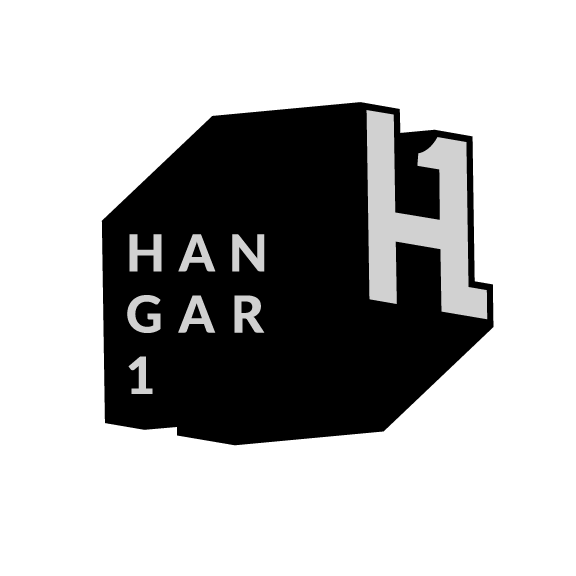Volunteering at Hangar 1
Walking into Tempelhof’s vast hangar 1, I felt intimidated by the sheer scale of the structure. But my attention was soon diverted from the big picture to the small, as a little girl came racing up to us and leaped into the arms of Amanda, a fellow volunteer I’d just met. Energy embodied, she introduced herself as Iman while playfully tugging on Amanda’s ponytail and generally charming everyone within earshot.

Though not all the children we met that day have the same level of energy and extroversion, I think it’s fair to say that Iman’s reaction represents some of the feelings these playdates evoke in the kids who take part.
The setup is simple but hugely effective. Every Saturday, a small group of Hangar 1 founders and volunteers visit Tempelhof to engage the children who live there in art and play. The last time I was inside the disused airport was during a music festival a few years ago. Today, it’s almost unrecognizable from its former incarnations, having been repurposed to house around 1300 refugees in small, temporary cabins that have been erected throughout the space.
Each session, volunteers bring prepared activities and the necessary materials. So far, they’ve done things like t-shirt painting and plaster modeling, catering to a range of ages from toddlers to teens. On the day I visited, co-founder Clemmie came equipped with a large canvas with an outline of the iconic airport overlaid in masking tape. With the canvas on a pallet and plastic cups filled with paint, we were free to let loose on the canvas. Some painted their hands and made prints, while others turned their attention to a different canvas altogether.
To me, the experience felt intuitively positive for the children. In a human way that transcends cultural confines, there’s something satisfying about letting kids be kids. As art therapist Gretchen Miller puts it, “Art making is a natural expression for children. They’re very open and ready to engage with it. It really helps build that sense of self and emotional expression. Giving them that at a young age, while they’re still in childhood, will hopefully help them be stronger as they move through adolescence and into adulthood, and be more able to develop those coping skills.”
These sentiments were echoed by co-founder Maria. “This experience is extremely important for the kids, especially as they begin to integrate and start school,” she explained. When the workshop program first started back in September 2015, the team noticed the children struggled to share or cooperate with each other. “They tended to grab the materials and run away,” Maria told me.
A year on and the workshop I attended was relatively harmonious. “You can see that now the children can switch between working in a team and on their own,” said Tanya, another Hangar 1 cofounder. “They can also use the materials skillfully and have started taking their own initiative.” It’s true that among the group, there was a definite sense of trust and goodwill.
The workshops happen every week, without fail. At a time in their life when so much is uncertain, this regularity has surely helped the children to relax and enjoy the experience and to trust in each other and the wider world.
Indeed, among art therapy’s well-documented benefits is the establishment of a safe space, both literal and figurative, wherein children can feel a sense of control over their environment. And though what’s happening at Tempelhof is not art therapy in any technical sense—art therapy necessarily involves the presence of a trained therapist—there’s no doubt that these workshops are therapeutic.

According to an article by the United Nations High Commission for Refugees (UNHCR), even without employing official methods, art in itself “can provide a vehicle for self-development and personal expression.” In Greece, such an ad hoc approach to art as therapy won Mercy Corps a United Nations Nansen award, in recognition of outstanding service to the cause of refugees.
Aside from the sanative benefits of the workshop, I was struck by the children’s practical art skills. “When we started out, they were doing really straightforward things like painting butterflies,” said Tanya. “Now, they have a good grasp of abstract art and techniques.” The creative results of that day provide proof if any more were needed, of such progress.
I was also impressed by the way the activity seemed to empower the children in small but significant ways. Given the freedom, they were able to make decisions about aspects of their artistic approach, such as colors, textures, brushes and technique. Building responsibility through an agency is a crucial aspect of child development, and it was heartening to see thoughtfulness and creativity blossoming in the kids, each in their own way.
It’s clear that the playdates positively affect the children in so many ways. But Tempelhof is a temporary space, a relatively short-term solution. The Hangar 1 team understands the value of the support they offer, and eventually aim to open a permanent space, so that vulnerable young people always have somewhere to go, to engage and to experience the myriad therapeutic benefits of art.
Words by Natalie Holmes

